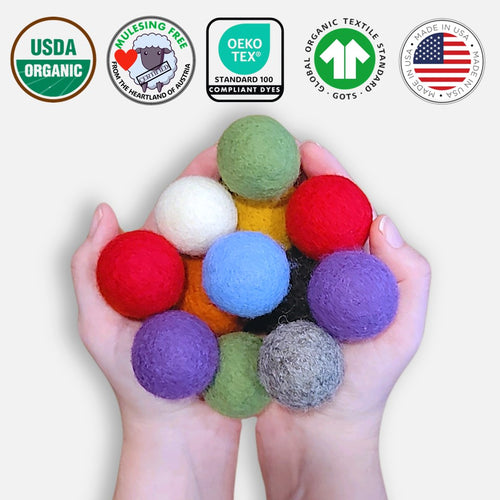Your Cart is Empty
Free 2-5 day delivery | No minimum purchase required
Free 2-5 day delivery | No minimum purchase required
Shop
Learn
Are Your Cats Playing Together or Fighting Each Other?
 by K Marie Alto Updated
9 min read
by K Marie Alto Updated
9 min read

Cats are a lot like children: sometimes they get along great, and sometimes they're ferocious enemies with vendettas as deep as the sea, usually over something like a toy that moved wrong or a snack that was eaten too fast.
Cats are also a lot like children in that one of their favorite ways to play with each other tends to be some form of roughhousing. While you can discipline children and tell them to get along, it's a lot harder with cats.
On top of that, it's a lot harder to tell whether or not cats are just roughhousing or if they're legitimately fighting with one another.
They make scary noises, swat at each other, and hold intense stare-downs, and it can look a lot like a fight if you don't know what you're seeing.
So, are your cats playing with each other, or are they fighting? Let's talk about it.
Table of Contents
Are Your Cats Fighting?
The simple answer is that most of the time, your cats are playing.
This is especially true if they're littermates or long-time housemates; that is, cats who are familiar with each other.

Fighting is more likely if you're introducing cats to each other for the first time or just relatively recently.
They can scuffle with each other if they aren't comfortable with each other, if one of them is fiercely territorial, or if they're still trying to sort out territories within the household.
It's important to keep this in mind, too, since you may need to invest in a second feeding station, bed, and litter box if one cat is bullying another out of theirs.
If your cat is encountering a visitor cat – through a window, or when they're both outside, or if a friend brought their feline over – then there may be some fighting, too.
A lot of this tends to depend on the temperament of the cats involved and how they view territory. Some of the more territorial cats will fight off any other cat that comes into their zone, while others might be okay with pretty much anything.
What Are the Signs that Cats Are Fighting?
If two cats are fighting, what should you look for? Here are the signs to keep in mind.
Claws out. Cats that are fighting are likely to have their claws out and visible and will be more likely to swat, strike, bat, and swipe at one another.
This is an escalation, though! Keep in mind that cats really don't like physical confrontation. They'll do a lot of posturing and vocalizing before they get physical and will only resort to violence if an interloper is aggressing on them.
Cats may be incredible hunters, but they hate confrontations they aren't in command of. In the wild, a fight can lead to debilitating injury, infection, or even death in extreme cases.
The repercussions are less severe with cats we can just take to the vet, but you still don't want to let them fight if you can avoid it.
Posturing. In a cat fight, the cats will tend to be very tense and stiff. They'll do a lot more staring down each other and making a lot of noises rather than physical aggression.
Often, they will be standing sideways as a way to show how big they are and dissuade the other animal from coming after them.
If one cat is a clear aggressor and the other is defensive, the aggressor will tend to be larger and calmer, while the defender will be crouched, ears back, and more submissive, or at least ready to flee if they can.

Fur and tail. A cat in a legitimate fight is going to fluff up their fur and tail, again, as a way to make themselves look bigger.
Wild animals (and animals like our feline friends who are closely descended from wild animals) don't want to get into confrontations if they can avoid it for all the reasons I already listed.
One of the more reliable signs that an animal isn't something to fight is when they're larger, so cats fluff themselves up. They'll usually point their tails straight up, though they may be nervously lashing it side to side as well.
Facial expressions. Cats that are fighting are going to express it in their body language, and their facial expressions are a key part of that body language.
- Their eyes will be wide open with dilated pupils, keenly attuned to even the slightest twitch from the other feline. They'll have locked eye contact and may take any deviation or distraction as cause to attack in a moment of weakness. Incidentally, this is why the "slow blink" is a sign of comfort and familiarity from a cat and why staring at them is less likely to get them to come to you.
- Their ears will generally be laid back or flattened against the sides of their head. This serves two purposes. The first is that it's not a usual position for cat ears, so it can be a sign of "no really, this is serious" to the other cat. You can see this in flashes if, during play, one cat accidentally hurts the other. It's also defensive; since ears are vulnerable to catching a stray claw, flattening them down helps reduce the risk of injury.
- Their whiskers will be spread out and forward. This can be harder to see on some cats, but it serves as another way to react very quickly to incoming attack or aggression.
- Their mouths will likely be open and baring teeth, especially during the vocalizations.
Unless you're totally inexperienced with cats, you'll be able to tell pretty quickly when a cat is being legitimately aggressive because, most of the time, these won't be the kinds of expressions they'll have when they're around you.
The exception is if you're used to dealing with feral cats, in which case you'll be experienced enough to know what's going on.
Vocalizations. Cats that are in a stand-off especially are going to be making some very distressing noises at one another. They'll be growling in that low, moaning way that cats growl (it's not at all like a dog growl), and they'll hiss at one another.
There's no meowing here. If you've never heard a cat's "fightin' words" before, they can feel primally dangerous, even coming from something as small as a housecat.
Are Your Cats Playing?
Most of the time, if your cats are tussling with one another, they're playing. Even when that playing seems to get strangely violent, and the noises they make sound distressing, it's nowhere near what a real cat fight is like.

The truth is, cat playing can often feel a lot like fighting just because, in a way, it is fighting. Cats play-fight with each other as a way to "train" for fighting, to get used to physicality, and, yes, to establish some kind of pecking order.
Kittens tend to be a lot more "socially playful" when they're young. The older a cat gets, the less likely they are to engage in play with each other in the same way; instead, they'll be more focused on playing with toys and other objects.
This does vary from cat to cat, though; some are more socially playful well into their adult years or even into old age. This can be especially true with littermates who consistently play with each other, as well as when a cat parent is teaching her kittens how to be playful and where the limits are on violence.
What Are the Signs that Cats Are Playing?
Cats that are play fighting will be a lot more physically active, for a longer period of time, than if they were fighting. Again, cats don't like to fight if they can avoid it because injuries are serious business. Playing, though, they'll do that all day if they feel like it.
One of the key factors in play fighting is activity. Cats that are playing with each other will be a lot more active; they'll stalk one another, pounce, tussle, and flee, and repeat the process.
They wrestle, play bite at each other, swipe and bat at each other with their claws pulled back so they're not risking doing any damage, and can even roll around and expose their bellies.
Often, cats that are play fighting will take turns being the aggressor. One pounces on the other, they tussle and separate, then the other one does the pouncing.

Critically, they aren't going to be engaged in a tense stand-off. There's no sideways posture, no hair standing on end, no deep staring and growling.
In fact, cat vocalizations while they're playing are going to be fairly minimal. They might make little grunts and whines, but they won't growl or hiss. Sometimes, the only noises they make are those brief whines if their playmate goes a little too hard.
Other signs, like ear posture, will be brighter and happier. They won't be laid back or flat as in a real fight.
When it comes right down to it, you can usually assume that cats are playing with each other unless there's some very serious posturing and growling going on, or they draw blood, or there's another reason why they'd be aggressive toward one another.
Cats: Fighting or Playing FAQ
Now, let's go through a few common questions I know you're dying to ask.
Why do cats fight with each other?
Play fighting is socialization, but real fighting is much more serious. As such, the reasons behind those fights tend to be more serious as well.

They can include things like:
- Feral cats that aren't used to one another being forced together.
- Cats being introduced to each other for the first time, especially if one or both aren't well-socialized.
- Resource scarcity. Not necessarily even now, but if a cat has had to fight to defend a meal in the past, they'll be a lot more defensive of their resources.
- Territorial defense. Cats like to have a space that is "theirs," and if another cat, especially one they don't know, encroaches on that territory, a fight can ensue.
There are also some more obvious reasons, like a mother cat protecting her kittens when they're very young and defenseless. Sometimes cats can also get aggressive if they're sick, usually from something like a UTI.
Should you stop cats from fighting?
If you see two cats that are poised to fight (rather than play), you might want to intervene to keep them both safe and defuse the situation. You can do this, but only if you do it safely.
Do not intervene by stepping between them, putting a hand between them, or trying to grab at them. That can get you attacked, and then you're in for a trip to the ER to get some stitches and some shots.

Instead:
- Try a positive distraction. Cracking open a can of tuna, rustling a bag of treats, or flipping a toy around nearby might distract one or both cats and defuse the situation.
- Make a noise a bit away. Something like a ping-pong ball bouncing nearby, clapping from a distance away, or otherwise distracting them might work.
- Sliding a barrier between them, such as a wall of cardboard, can break their stare-down and get them to back off.
On the other hand, try not to resort to something like a spray bottle, a loud close noise like a can of coins, a clap right behind one of them, or trying to startle them. These can disrupt a fight, but they're stressful for the cats and can make it even harder to socialize them later.
Can you get cats to stop fighting each other?
Sometimes! One of the more common causes of aggression is introducing two cats to each other, and you can definitely socialize two cats through indirect introductions to build familiarity before letting them interact.

On the other hand, an older, poorly socialized, feral cat is going to be a lot harder to break from their habits.
Sometimes, cats just don't want to be in a place with other cats, and there's not much you can do about it but acquiesce to their wishes. Don't try to force it if you're just going to end up with accidents, injuries, and stressed felines.
Do you have any other questions about fighting or playing in cats? Let me know!
K Marie Alto
K. Marie is an animal lover, wife, kitty mom, dog auntie, writer, and co-founder of Toe Beans, a proud American family-owned online boutique pet supplies store focused on the improvement of the life of furry family members via pet parent education, better products, and advocacy. She has over 20 years of experience as a pet momma. She loves sharing her personal journey and experience as a pet parent via her blog and Facebook page where she currently has more than 50K followers (@furrytoebeans) and counting :-). Read more
Leave a comment
Comments will be approved before showing up.
Also in Pet Parents Blog by Toe Beans

What You Should Know Before Adopting a French Bulldog
by K Marie Alto May 29, 2025 10 min read
Learn what to expect when adopting a French Bulldog, including their care needs, health issues, and tips to prepare for a happy life with your new companion.

Strategies to Remove the Smell of Cat Urine Permanently
by K Marie Alto May 22, 2025 9 min read
Discover how to remove the smell of cat urine permanently with our guide on effective cleaning strategies using common household items and practical methods.

Top 9 Large Dog Breeds That Keep Shedding to a Minimum
by K Marie Alto May 15, 2025 9 min read
Learn about nine large dog breeds that keep shedding to a minimum, helping you manage fur effectively while enjoying the companionship of a big, lovable dog.
Related Products

Cat Ball Toys | Handmade in the USA with 100% Austrian Wool
$20.99

Cat Kicker Toy | Organic | Handmade in the USA
$19.95

Cat Grass | USDA Organic | Grown in the USA
$12.99
Recent Articles
- What You Should Know Before Adopting a French Bulldog May 29, 2025
- Strategies to Remove the Smell of Cat Urine Permanently May 22, 2025
- Top 9 Large Dog Breeds That Keep Shedding to a Minimum May 15, 2025
- Why Do Cats Hide? The Top 4 Causes Explained May 08, 2025
- What You Should Know Before Adopting a Pit Bull Lab Mix May 01, 2025
- What To Expect When Introducing a Kitten to An Older Cat April 24, 2025
- The Guide to Dog Enrichment Toys for a Happier Pup April 17, 2025
- Techniques To Stop Your Cat from Begging While Eating April 10, 2025
- The Truth Behind Zeus, The World’s Largest Great Dane April 03, 2025
- Bengal Cat Guide: History, Health, and Personality Traits March 27, 2025
